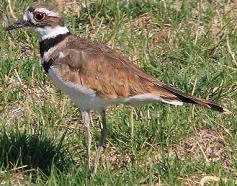Killdeer 
Killdeers are a shorebird that has become comfortable
living in agricultural, and suburban areas, making them the most
common plover in North America.
Identification - Pictures and Killdeer
(Charadrius vociferus)
Killdeers are Plovers about 9 to 11
inches. Both sexes are brown above, and white below with
a reddish brown rump. They have two black bands around the
neck, and an orange eye ring. They have a white forehead,
and the top of the head is brown. They have long, pointed
brown wings, and tail. When they fly they show a
golden-red rump, and white wing strips. Male and female killdeer
look similar in appearance. The young birds look like
the parents, but only have one neck band, and they have buffy
tips on their back, and wing feathers.
Photo by Keith
Lee. The camera I use is the Canon
EOS 40D. Visit All-birds store
Killdeer sound
These are very noisy birds, and are often heard
at night. In spring the male can heard singing kill-deer kill-deer as he circles his territory.
An alarm call is a nasal deet-deet-deet. They also have
a low trill. In the fall small flocks will fly around, and
around calling kill-deer. Sound
Preferred Habitat
They are year-round residents of the western U.S.
In the summer they range from southern Canada, and Alaska to
Northern U.S. They winter in Mexico, and Central America.
They like agricultural areas, fields, lawns, airports,
riverbanks, shores, mudflats and open fields with gravel and little
vegetation. They have adapted well to man. Even
though they are shorebirds that prefer shorelines, they may
live, and nest almost anywhere, even if there is no body of
water nearby.
Breeding and Nesting
Killdeer normally breed in early spring,
starting with the male flying in big circles around the female,
calling, kill-deer over, and over. The birds nest on the
ground. They do not build a nest but will lay their eggs
in a depression in gravel. The nest, and speckled eggs
blend easily into the background making them hard to
see. They will nest almost anywhere and have been known
to nest in driveways.
If you get near a nest or babies, the adult
Killdeers will often play like they are injured with a broken
wing. They will act like they can barely walk in an
attempt to lead you away from the nest. They are very
good at this game, and will let you get just about in reach
before they scurry away a little farther. If you or potential predators are not following them they will come
closer and get louder. When they get you far enough away
that they feel the babies are safe the wing will miraculously
heal. If you look around you can often spot the little
ones hiding in the grass. Another deception they use is
acting like they are sitting on a nest. When a predator gets near they move to a new spot to settle.
Both parents take turns incubating 4 buff, speckled
eggs for 24 to 28 days. As soon as their downy
feathers dry after hatching from the egg the babies start
running around after the parents, and looking for food.
Killdeer are in a group called precocial birds. These
birds are in the egg longer that other birds so when they
hatch out they are more developed. They can't fly yet,
and they are a little clumsy but they are ready to go.
Songbirds such as bluebirds are altricia, and require more care
from the parents after hatching. In 20 to 30 days the
young birds will be self sufficient.
Food
The main diet of Killdeers is insects, and invertebrates.
To learn about other favorite
birds click here.

|
